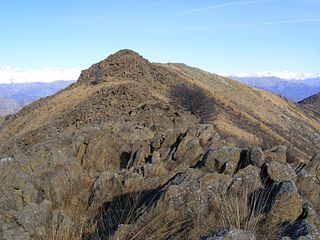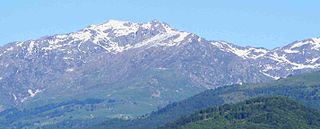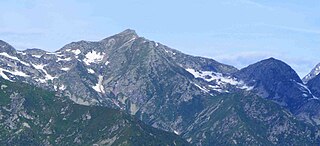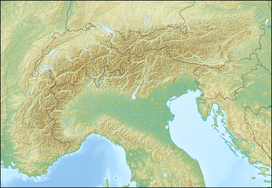
Rocciamelone is a 3,538 m high mountain in Piedmont, Italy, near the border between Italy and France.

The Susa Valley is a valley in the Metropolitan City of Turin, Piedmont region of northern Italy, located between the Graian Alps in the north and the Cottian Alps in the south. It is one of the longest valleys of the Italian Alps. It extends over 50 kilometres (31 mi) in an east-west direction from the French border to the outskirts of Turin. The valley takes its name from the city of Susa which lies in the valley. The Dora Riparia river, a tributary of the Po, flows through the valley.

The Geography of Piedmont is that of a territory predominantly mountainous, 43.3%, but with extensive areas of hills which represent 30.3% of the territory, and of plains (26.4%).

Monte Lera is a mountain in the Alpi di Lanzo, a sub-group of the Graian Alps, with an elevation of 1,368 m. It is located between the Val Casternone and the Ceronda valley in the communes of Val della Torre, Varisella and Givoletto.

Monte Colombano is a mountain in the Alpi di Lanzo, a sub-group of the Graian Alps, with an elevation of 1,658 m.

Colma di Mombarone is a mountain of the Biellese Alps, a sub-range of Pennine Alps, in northern Italy. It visually marks, along with Monte Gregorio on the opposite side, the entrance of Aosta Valley from the Po plain. On its top in 1900 was built a huge statue, still located there, of Jesus Christ.

Monte Barone is a mountain of the Alpi Biellesi, a sub-range of the Pennine Alps. Due to its isolation it offers a noteworthy point of view towards the Po plain and can be seen from quite a long distance away.

Monte Orsiera is a mountain in the Cottian Alps belonging to the Province of Turin (Italy).

Monte Cresto (2,548 m) is the third highest peak of the Province of Biella after Monte Mars (2,600 m) and Monte Bo (2,556 m).

Punta Sulè is a 3,384 m a.s.l.mountain of the Graian Alps, located in Italy.

Monte Politri or Bric Rosso is a 3,026 m a.s.l. mountain of the Cottian Alps, located in Italy.

Carmo di Brocchi is a 1,610-metre (5,282 ft) mountain of the Ligurian Alps, in Italy.

Monte Spinarda is a 1,357-metre (4,452 ft) mountain of the Ligurian Prealps in Italy.

The Punta Nera is a mountain of Savoie (France) and of the Province of Turin (Italy). It lies in the Cottian Alps range. It has an elevation of 3,047 metres above sea level.

The Monte Civrari is a mountain of the Graian Alps, with an elevation of 2,302 m.

The Punta Lunella is a mountain of the Graian Alps, with an elevation of 2,772 m.

The Punta Mirauda is a mountain of the Ligurian Alps located in Piedmont.

Monte Cianea is a 1,226-metre (4,022 ft) mountain of the Ligurian Prealps, in Italy.

The Monte Fantino is a mountain of the Ligurian Alps located in Piedmont.
The Ligurian Prealps are a mountain range in northwestern Italy. They belong to the Ligurian Alps and are located between the regions of Piemonte and Liguria. Their highest summit is the monte Armetta, at an elevation of 1,739 metres (5,705 ft).























